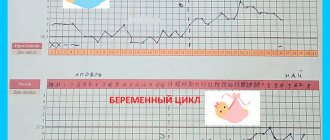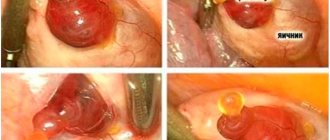Sex hormones influence many aspects of a woman's life. Equal functioning of the internal secretion organs allows you to maintain tonus not only the reproductive system, but also the entire body. The level of hormones also affects the value of basal temperature.
Basal temperature is the temperature of the internal organs. The most accurate readings can be taken in the morning, after a long night's rest. Any physical activity or stress will greatly distort the results obtained.
There are not many places in the body where basal temperature can be measured. An indispensable condition for accurate measurement is the presence of contact between this cavity and the internal organs. There are several such places in the body. These are the oral cavity, rectum and vagina.
The vagina is in contact with the uterus. By measuring the temperature in the vagina, we can assume what processes are occurring in the ovaries and uterus. And although this method is considered not entirely reliable, it allows you to determine the onset of ovulation.
Why measure BT - why do the readings change?
Measuring basal temperature and drawing up an appropriate chart will allow a woman to assess the condition of her reproductive system. Since the body of each representative of the fair sex works in its own mode, then the schedule of each lady will look different. BT indicators can be influenced not only by the characteristics of the body and the presence of pathologies, but also by the day of the cycle.
To get a complete picture, you need to observe changes in BT for at least 4 months. Measurements for 1 cycle will not allow you to make correct calculations. It does not matter exactly how the measurement was carried out: it could be oral, vaginal or rectal temperature, the main thing is that each time the measurement is carried out similarly to the previous one.
The BT schedule can tell the doctor a lot:
- Most often, these values are used to determine pregnancy when menstruation is delayed;
- you can find out whether the egg is ripe, that is, the moment of ovulation is visible on the graph;
- you can determine the presence of gynecological diseases and inflammatory processes;
- the functionality of the endocrine system is determined;
- The level of hormone secretion by the ovaries is assessed.
If a woman has been unable to get pregnant for a long time, keeping a BT schedule will help determine the presence of disorders in the reproductive system, such as:
- hormonal imbalance that does not allow the embryo to gain a foothold in the endometrium;
- hiding gynecological diseases that cause infertility;
- infertility due to lack of ovulation as such;
- problems in the activity of the endocrine system.
By measuring BBT, you can significantly increase your chances of conceiving; some women use such charts in order to conceive a baby of a certain gender.
It should be remembered that it is impossible to make a diagnosis on your own based only on basal temperature readings; to confirm it, you must undergo laboratory and instrumental tests. Only a doctor can make an accurate diagnosis.
Summarizing
The method of measuring basal temperature is based on calculating the exact date of ovulation, during which a sharp increase in temperature occurs. However, in order to get pregnant, a woman needs to rely not on the temperature itself, but on its dynamics throughout the entire cycle.
In most cases, you can get pregnant at a temperature of 36.2-36.9. But immediately after this, BT must necessarily increase.
You need to understand that the basal temperature can be different for each woman, which means that this method of pregnancy planning is considered not very reliable. It is not necessary to judge the onset of ovulation or pregnancy; for reliability, additional ultrasound monitoring is necessary.
It’s definitely not worth making any decisions on your own based only on the basal temperature chart. Only a doctor can interpret the results of the graph.
Measurement rules
In order for the measurement of basal temperature to provide the most reliable information, you need to choose the right moment for measurements, namely the time when the temperature is lowest. Compliance with the following rules for measuring BT is the key to obtaining accurate information:
- Basal temperature should be measured only after waking up from sleep, which lasts at least 5-6 hours without interruption.
- Measurements are taken at the following points: vagina, rectum (the most accurate data), mouth. If measuring in the mouth, the thermometer should be placed under the tongue for 5 minutes. At other points, it is enough to hold the thermometer for 3 minutes.
- The measurement is carried out at the same time each time with a spread of no more than half an hour.
- You need to measure BT using one method and one instrument. A mercury thermometer is better suited for these purposes.
- You need to prepare the measuring device in the evening. The thermometer must be knocked down and placed near the bed so that you do not get up in the morning, but take readings immediately when you wake up.
- After waking up, before taking measurements, under no circumstances should you get out of bed, stretch or move actively.
- The BT value is influenced by every active movement and time. Every hour after waking up, it rises by 0.1 degrees, so measuring it during the day and evening is pointless, the result will be useless.
- If you need to interrupt your night's sleep for any reason, then you need to do the things you have planned, and then go to sleep for another 3-4 hours, and only then take BT measurements.
- You need to take readings in a supine position, which means taking measurements without getting out of bed.
- As soon as the thermometer is removed, you immediately need to record the readings on a graph.
- If the mercury column on the thermometer is located between two divisions, you need to take into account the lower mark.
- If a woman works a night shift, readings should be taken after daytime sleep.
- On the graph you need to note all incidents that may have an impact on the value of the measurements, such factors include intimate relationships the day before, a long stay on the road, increased body temperature, taking sleeping pills, hormonal or sedative medications and drinking alcohol.
- Measurements are best taken before 8 am.
- Since the chart needs to be completed for about 3 months, measurements are taken daily, even on critical days.
Since the female reproductive system can rest twice during the year, ovulation does not occur during this time, conception can only be suspected if the graph shows that it was in this cycle.
BT standards at different stages
It is quite natural for the female body that BBT changes during the cycle. But to determine what is normal, it is necessary to carry out measurements for at least 3 months in order to obtain reliable data. Let's consider what the acceptable BT values are at different stages of the menstrual cycle, as well as what this or that temperature can mean during systematic measurements, and how many days before menstruation its value begins to fall.
You need to start drawing up a schedule on the first day of your period, that is, on this day you need to take the 1st measurement. Its value increases slightly in the first days, so this indicator does not take part in the calculations. On average, basal temperature during menstruation can fluctuate between 36.3-36.5 ° C; this value can remain the entire 1st phase of the cycle. These are optimal conditions for follicle growth under the influence of the hormone estrogen.
Immediately before a mature egg is about to leave the ovary, BT begins to fall by a few tenths of a degree, and then sharply increases to 37-37.2 ° C. An increase in basal temperature indicates the onset of ovulation and the beginning of the 2nd phase of the cycle; such indicators can remain until the end of the cycle.
What the basal temperature will be before menstruation depends on the state of the egg: whether it is fertilized or not. At the site where the follicle breaks through the wound on the wall of the ovary, a corpus luteum forms, which produces the hormone progesterone. The result of fertilization largely depends on it. Under the influence of progesterone, BT increases to 37.0-37.5°C. This is the best time to conceive. Until the end of the cycle, the graph will show values within these limits. When conceiving, similar indications are noted before and after the delay - this is the surest sign of pregnancy. To confirm its occurrence, you can additionally use a test.
A week before your period, normal basal temperature can remain around 37°C, the highest point should not exceed 37.5°C. One nuance must be taken into account that with a 4-week cycle, it is at this time that implantation retraction can be observed - BT decreases by several tenths of a degree during the implantation of the embryo into the uterine wall. In this case, the expectant mother may feel pain in the lower abdomen, and minor bleeding may also occur. Not every woman may experience a decrease in BT during embryo implantation, but over time the value still levels out. If fertilization does not occur, then the level of progesterone drops, and this leads to a decrease in BT on the eve of menstruation.
3 days before menstruation, BT is usually characterized by a drop of 3-5 tenths of a degree. A variant of the norm during this period will be considered its value in the range of 36.7-37.1°. But in general, for each woman before her period, the norm of basal temperature will be individual.
By measuring basal temperature, you can assess the coherence of the female body, you can say exactly when the time has come that is most suitable for conception, and specify the days on which you can not use protection during sexual intercourse. It is best to take measurements several cycles in a row to achieve greater accuracy of the results.
Since the functioning of the female body is highly dependent on hormones, it is quite natural that, due to their level, the BT value can increase and decrease. Low basal temperature is observed immediately before ovulation and in the last days of the cycle. In the latter case, this means that fertilization has not occurred and you need to prepare for the arrival of menstruation. If the basal temperature does not drop at this time, but remains at 37 and a half, or even 38°, this may indicate the presence of an inflammatory process or disease in the body. During pregnancy, BT does not increase more than to 37.2-37.5°C, which means that 38°C is an alarming signal for a woman, meaning that she urgently needs to see a doctor.
The basal temperature after menstruation remains within the range of 36-36.9 ° C, but if it remains at this level throughout the entire cycle, it means that this month the reproductive system decided to rest, since when ovulation occurs there would be a temperature rise. Pregnancy will not be possible during this cycle. You only need to panic if a similar situation repeats several cycles in a row - this is a reason to seek help from a specialist.
Hypothermia
A decrease in body temperature during pregnancy may be associated with the following conditions:
- endocrine pathology;
- decreased overall body tone, loss of strength;
- malnutrition (including strict diets);
- prolonged exposure to the cold;
- internal bleeding;
- taking certain medications (including overdose).
A decrease in body temperature to 35.7°C or lower indicates serious problems in the body. In this condition, you should consult a doctor.
The decrease in basal temperature in pregnant women deserves special attention. Normally, after conceiving a child, the temperature rises and remains within 37 ° C until the end of the first trimester. A decrease in basal temperature earlier than this may be a sign of one of the following conditions:
- threat of spontaneous miscarriage;
- regressing pregnancy;
- ectopic pregnancy.
You can clarify the diagnosis after examination by a doctor. A blood test for hCG and a transvaginal ultrasound will help exclude a dangerous pathology.
The menstrual cycle is divided into phases that successively replace each other. Depending on the phase, the content of hormones in a woman’s body can either increase or decrease, and along with this, basal temperature indicators also change.
Basal temperature chart before menstruation
The BT graph is a regular linear graph with 2 coordinate axes, where the number of days in the cycle is plotted along the X axis, and the temperature value in degrees is plotted along the Y axis, the division value along the Y axis is 0.1°, while at the zero mark there will be a value 35.7°C.
Every day, immediately after waking up, right in bed, a woman measures her BT using any method convenient for her using the same thermometer. Having received the value, she places a point at the intersection of the day of the cycle and the reading on the thermometer. These points are then connected. Thus, you can clearly trace all changes in BT during the cycle. The graph clearly shows when it rises and when it falls.
During critical days, BT can be 36.6 ° C, a maximum of 36.7 ° C, then it declines, and immediately before ovulation it has the lowest value for several days. After the release of the egg, there is a sharp jump in progesterone in the body, followed by a jump in temperature, reaching 37-37.2°C. This level is maintained throughout the 2nd phase of the cycle, until the new cycle, and then gradually decreases.
Reasons for deviations in basal temperature
BT indicators may deviate from normal values characteristic of a particular phase of the cycle. If the deviations in basal temperature indicators are significant, then it is imperative to seek advice from a specialist.
Deviations in temperature readings for pathologies may be as follows:
- progesterone deficiency - the curve on the graph goes down sharply. The temperature may rise slightly, but does not last longer than a week. The temperature difference between phases is less than 0.4 degrees. The second phase becomes shorter (not 14, but 10 days), menstruation occurs prematurely;
- endometritis. With inflammation of the uterine mucosa in the first days of the cycle, BT increases to 37 degrees, instead of falling. With such symptoms, you can find out about the presence of pathology, but to confirm it you need to contact a specialist;
- problematic pregnancy. If BT is noted at 37 and a half degrees, there are no periods, which indicates pregnancy, but bloody “smear” from the vagina begins, this may be a sign of spontaneous abortion. If the test does not confirm the presence of pregnancy, it may be ectopic;
- no ovulation. When the measurements are arranged haphazardly on the graph, sometimes jumping up, sometimes falling down, there was no ovulation in this cycle and conception will not occur. If this repeats several cycles in a row, consultation with a gynecologist is required;
- inflammation of the appendages can be diagnosed when, even in the first phase, a high basal temperature is measured at 37°; confirmation of the presence of an inflammatory process is an increase in BT to 38 degrees in the 2nd phase of the cycle.
When taking hormonal contraceptives, scheduling BT will be ineffective, since these drugs significantly distort the measurement values.
Basal temperature measured according to all the rules allows a woman to solve many issues related to conception and the health of her reproductive system. Therefore, every representative of the fair sex should know how to correctly draw up a BT schedule.
Hypoglycemia
In the first trimester of pregnancy, many women suffer from toxicosis. With this disorder, appetite decreases, nausea and vomiting often occur. As a result, the pregnant woman's body may experience a deficiency of essential nutrients. As a result, the general condition of the body worsens, and temperature values may decrease. Other symptomatic manifestations of this pathology are:
- tachycardia;
- intense sweating;
- slow blood circulation;
- headache;
- respiratory dysfunction.
After regular nutrition is established, body temperature returns to normal. If you cannot cope with the problem on your own, you should contact a specialist who will select the appropriate diet.
Poor nutrition can lead to the development of anemia. This pathology is also characterized by a decrease in temperature values.
In addition, this disease is manifested by increased weakness, tachycardia, dry mouth, deterioration of the condition of nails, hair, and skin. A decrease in hemoglobin interferes with the normal development of the fetus. The child may be born with iron deficiency and other pathologies.
The temperature rises before menstruation - what is it?
If the temperature normally decreases before menstruation, then what could its increase mean? After ovulation, the production of progesterone begins to increase, which has a strong effect on the thermoregulation center in the brain. In this case, some women may feel a slight increase in temperature a week before their period. And after they start, she returns to normal. However, this reaction is not observed in many people.
In addition, the basal temperature before menstruation may rise due to pregnancy. This occurs as a result of hormonal changes. However, one can talk about pregnancy only after a delay, then the woman must do tests.
Therefore, by monitoring the temperature, you can find out if you are pregnant. However, it is advisable to measure it rectally. If the rectal temperature rose after ovulation and fell before menstruation, then pregnancy did not occur. If it rises within 37.5 degrees and if there is a delay, it is assumed that conception has occurred.
Basal temperature before menstruation - deviations
The temperature at the beginning of menstruation makes it possible to identify pathological changes, these include:
- Inflammation of the uterus (endometritis) is characterized by a slight drop in temperature before the first day of menstruation, while during it it is more than 37 degrees.
- Progesterone deficiency, that is, luteal phase deficiency, is characterized by a slow (more than 3 days) rise in temperature values with a difference of less than 0.4 degrees. In addition, the second phase is shortened to 10 days. In this case, menstruation occurs earlier than expected. In addition, the rise in temperature can last less than a week.
- An indirect sign may indicate a possible pregnancy - the basal temperature is more than 37 degrees for 14 days, and there is no drop in temperature. In this case, menstruation is delayed. If the temperature persists, but discharge begins, you can suspect a threat of miscarriage.
- With inflammation of the appendages, the temperature in the follicular phase rises to 37 degrees in a few days. High rates are also present in the second phase. Before menstruation they do not decrease, and during it the temperature is more than 37 degrees.
Depending on what rectal temperature was maintained before menstruation, it is possible to determine not only the presence of pregnancy, but also some pathological conditions of the genital organs.








